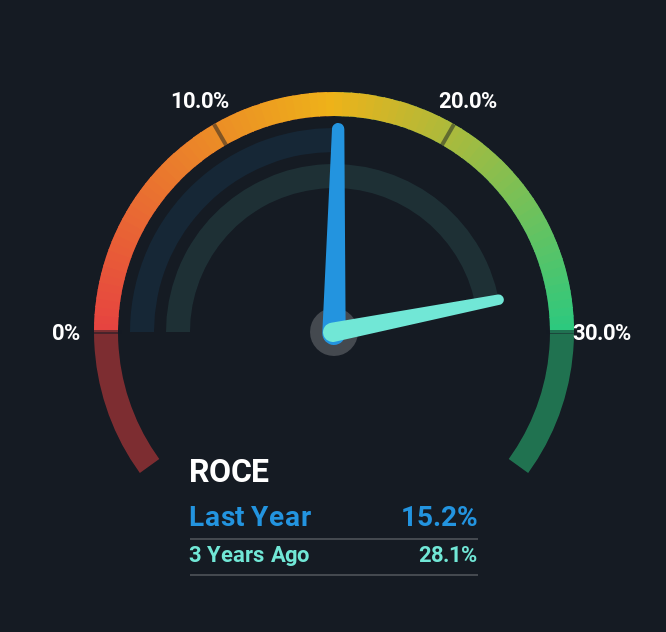Returns On Capital Signal Tricky Times Ahead For FDJ United (EPA:FDJU)
To find a multi-bagger stock, what are the underlying trends we should look for in a business? Firstly, we'd want to identify a growing return on capital employed (ROCE) and then alongside that, an ever-increasing base of capital employed. This shows us that it's a compounding machine, able to continually reinvest its earnings back into the business and generate higher returns. Although, when we looked at FDJ United (EPA:FDJU), it didn't seem to tick all of these boxes.
Return On Capital Employed (ROCE): What Is It?
Just to clarify if you're unsure, ROCE is a metric for evaluating how much pre-tax income (in percentage terms) a company earns on the capital invested in its business. The formula for this calculation on FDJ United is:
Return on Capital Employed = Earnings Before Interest and Tax (EBIT) ÷ (Total Assets - Current Liabilities)
0.15 = €568m ÷ (€6.6b - €2.8b) (Based on the trailing twelve months to December 2024).
Therefore, FDJ United has an ROCE of 15%. In absolute terms, that's a satisfactory return, but compared to the Hospitality industry average of 8.1% it's much better.
See our latest analysis for FDJ United

In the above chart we have measured FDJ United's prior ROCE against its prior performance, but the future is arguably more important. If you'd like to see what analysts are forecasting going forward, you should check out our free analyst report for FDJ United .
What The Trend Of ROCE Can Tell Us
The trend of ROCE doesn't look fantastic because it's fallen from 27% five years ago, while the business's capital employed increased by 302%. That being said, FDJ United raised some capital prior to their latest results being released, so that could partly explain the increase in capital employed. FDJ United probably hasn't received a full year of earnings yet from the new funds it raised, so these figures should be taken with a grain of salt. It's also worth noting the company's latest EBIT figure is within 10% of the previous year, so it's fair to assign the ROCE drop largely to the capital raise.
On a side note, FDJ United has done well to pay down its current liabilities to 43% of total assets. That could partly explain why the ROCE has dropped. Effectively this means their suppliers or short-term creditors are funding less of the business, which reduces some elements of risk. Since the business is basically funding more of its operations with it's own money, you could argue this has made the business less efficient at generating ROCE. Either way, they're still at a pretty high level, so we'd like to see them fall further if possible.
In Conclusion...
In summary, despite lower returns in the short term, we're encouraged to see that FDJ United is reinvesting for growth and has higher sales as a result. In light of this, the stock has only gained 29% over the last five years. So this stock may still be an appealing investment opportunity, if other fundamentals prove to be sound.
FDJ United does have some risks though, and we've spotted 2 warning signs for FDJ United that you might be interested in.
While FDJ United may not currently earn the highest returns, we've compiled a list of companies that currently earn more than 25% return on equity. Check out this free list here.
Have feedback on this article? Concerned about the content? Get in touch with us directly. Alternatively, email editorial-team (at) simplywallst.com.
This article by Simply Wall St is general in nature. We provide commentary based on historical data and analyst forecasts only using an unbiased methodology and our articles are not intended to be financial advice. It does not constitute a recommendation to buy or sell any stock, and does not take account of your objectives, or your financial situation. We aim to bring you long-term focused analysis driven by fundamental data. Note that our analysis may not factor in the latest price-sensitive company announcements or qualitative material. Simply Wall St has no position in any stocks mentioned.
 Wall Street Journal
Wall Street Journal